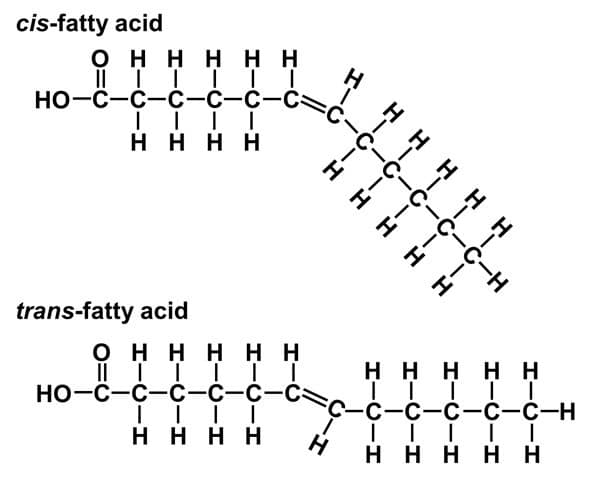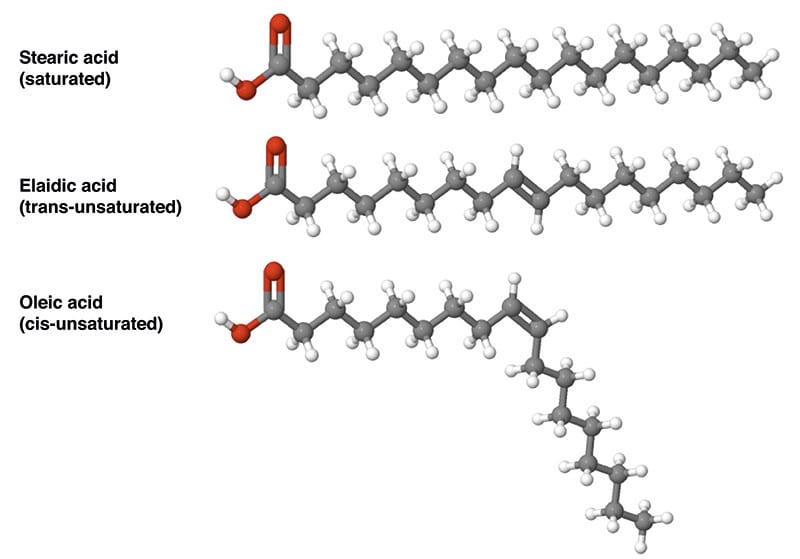Milk fat consists mainly of triglycerides. Triglycerides consist of three (tri) fatty acids that are chained to a carbon structure made of glycerine. Fatty acids, abbreviated FA, themselves also largely consist of a carbon chain with 4 to 24 carbon atoms (C) in a row, which are surrounded by hydrogen atoms (H). The end is an oxygen-hydrogen connection, the acid-part.
In the C chain, the C atoms are connected to each other with a single or double bond: C-C-C-C (single) or C-C = C-C (double). Furthermore, each C atom is connected to two hydrogen atoms (H). The double C bond limits the possibility of the H atoms to dock. Fatty acids serve both as a “fuel” and as a bioactive ingredient.

Bottom: C12:1t6 in a trans position in 6th place
Fatty acids are classified chemically according to various criteria
The length of the C chain: There are short, medium and long chain fatty acids. The number of carbon atoms in the chain is therefore decisive for this classification: C2 is acetic acid, C3 is propionic acid, C4 is butyric acid and so on. C2 to C5 are short-chain, C6 to C12 are medium-chain and C13 and longer are long-chain fatty acids. The chemical formula of butyric acid is: C4H8O2; four carbon, eight hydrogen and two oxygen atoms.
The presence of double bonds and their number in the carbon-line: Saturated fatty acids, only contain simple bonds. Fatty acids that contain double bonds between the carbon atoms are called unsaturated, and they may have one or several double bonds. A distinction is therefore made between saturated fatty acids (SFA, saturated fatty acids), monounsaturated fatty acids (MUFA) and polyunsaturated acids (PUFA). In general, with increasing chain-length and more double bonds FAs are bioactive regulators of the metabolism. The way to write the fatty acid in a formula is: C10:1 or C20:3, which corresponds to a chain of 10 carbon atoms with a single double bond and a chain of 20 carbon atoms with 3 double bonds.
A chemical spin can occur in the molecule: The spin leads to the H atoms of the C chain being adjacent or opposite, which is referred to as the cis position or trans position. Cis means on the same side, trans means on the opposite side. These terms have to do with the spatial curvature of the molecule. This can be seen, for example, with linoleic acid (C18:2). There is a conjugated twist called CLA (conjugated linoleic acid). The position of the double bond alternates with a single bond. The cis or trans positions are connected to the atom in the chain where the double bond is located: for instance, cis9, cis13, trans10 or trans11 (Fig. 2). In the case of double unsaturated compounds, this can be in a cis-cis position or a cis-trans position or a trans-trans position: cis9trans11, trans11cis13, cis9cis11. All are CLAs, because there is only one carbon atom between the two double bonds. Cis is abbreviated as c and trans as t; one example of CLA is therefore written as CLAc9t11.
Omega fatty acids: These are named according to the first position of the double bond. It is counted from the side that begins with the CH3 binding. Omega is also called n, hence n3, n6, n9 fatty acids. The omega numbering (n3, n6, n9) results from the position of the first double bond relative to the CH3 group. For example, alpha-linolenic acid (ALA): it is one of the most important n3 fatty acids. It is also described with the abbreviation C18:3-n3 or as C18:3c9c12c15, if the focus is on the position of the three double bounds in its cis-positions. ALA has 18 carbon atoms and the first double bond is in position 18 minus 3 = 15. Then there are 2 further double bonds, each of which has 3 carbon atoms removed, entries 12 and 9.
Iso fatty and ante-iso fatty acids: this name has to do with the branching on the alkyl (CH3) side of the molecule. This creates bioactive fatty acids.Even and odd fatty acids: The basic building block of fatty acids is either acetic acid (C2) or propionic acid (C3). In each step of chain extension, 2 carbon atoms are attached, and new fatty acids are formed. That’s why the series is created: C2, C4, C6, C8, etc. (even), but also C3, C5, C7, C9, etc. (odd).

Middle and below: mono-unsaturated FAs, C18:1.
Middle: C18:1t9, called Elaidic acid.
Below: C18:1c9, called Oleic acid.
Colours: Carbon = grey, Hydrogen = white, Oxygen = red
Processing
During the digestive process of fats, unsaturated fatty acids can become more saturated after the lipase (enzyme for digesting fat) starts working. In industry, fat saturation is also done artificially, which is called hardening of the fats. Palm oil, for example, is naturally too fluid for the production of margarine and must first be saturated. By removing the double bonds, the melting point of the fat increases and liquid fat becomes hard fat. During fat digestion, the long C-chains are broken down in small chains. The final products C2 or C3 fatty acids are used in many cell processes. However, if the fats are stored in the form of adipose tissue, for example, the chains are longer. A lot of cushioning fat contains C18:0, stearic acid (Fig. 2).
Enzymes are involved in all steps of building up and breaking down fats. The creation of unsaturated fatty acids in particular requires a lot of energy, while the breakdown in turn provides energy, for example for warming the body. In principle, we can synthesize the other n3 fatty acids ourselves in our metabolism. Of the unsaturated fatty acids, only ALA (C18:3 n3) is a real essential fatty acid for humans. Fatty acid synthesis, however, depends on the diet and needs. There are dietary recommendations for other long-chain n3, but also n-6 fatty acids, such as arachidonic acid (C20:4 n6) or docosahexaenoic acid (C22:6 n3) as building blocks of our brain and the brain functioning.
Names of some important fatty acids
- Butyric acid: short chain, saturated (C4:0). Is considered an indicator of a healthy colon;
- Fatty acids related to the nutrition of dairy products are C15:0 and C17:0, two odd fatty acids, respectively called pentadecylic acid and margaric acid;
- Conjugated linoleic acid: for example, grass-CLA, also called rumenic acid (C18:2c9t11). This form of CLA is considered to be one of the indicators for grass-based milk: CLAc9t11 and its sister CLAt11c13, as well as the preliminary stage from which they arise: trans-vaccenic acid = C18:1t11. All three FAs have in common the trans11-position. Compared to trans9 and trans10 FAs, these trans11 compounds are seen in connection with health-promotion. For instance, trans10 FAs are found in connection with the development of a fatty liver.
- Alpha-linolenic acid (ALA = C18:3c9c12c15 n3), an 18-carbon long-chain molecule with three unsaturated cis positions at C numbers 9, 12 and 15. This plant-based fatty acid is found in high concentrations in the growing parts of green plants and in oil seeds such as flax. It forms the basis for other long-chain fatty acids. During rumination, it is largely broken down (95-98%) in the cow’s rumen and becomes saturated.
- Eicosapentaenoic acid (EPA, C20:5 n3) and docosahexaenoic acid (DHA, C22:6 n3): They are also called fish fatty acids because, for example, they are found in cod and salmon living in cold deep-sea oceans, which feed on algae containing ALA. The carbon chain of alpha-linolenic acid is extended by 2 or 4 carbon atoms, additional double bonds are formed, so that there is a total of 5 or 6. This creates these very long-chain, unsaturated fatty acids. EPA and DHA are rare in nature, but the concentration of these fatty acids in the human brain is extremely high.
- Arachidonic acid (AA, C20:4 n6) is an important omega-6 fatty acid.




